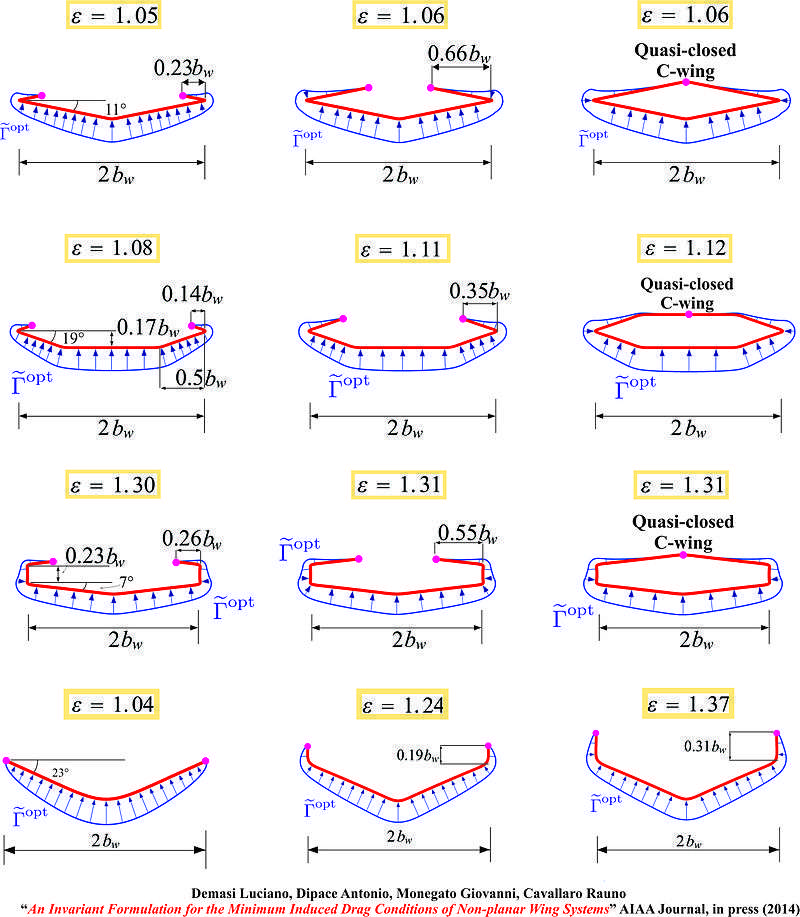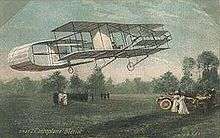Closed wing

A closed wing is a non-planar wing that uses a continuous surface, eliminating the wing tips. Closed wing designs include the annular wing (commonly known as the cylindrical or ring wing), the joined wing, the box wing and spiroid tip structures.[1]
A closed wing can be thought of as the maximum expression of a wingtip device, which has the aim of eliminating the influence of the wingtip vortices which occur at the tips of conventional wings. These vortices form a major component of wake turbulence and are associated with induced drag, which negatively affects aerodynamic performance in most regimes. A closed wing surface has no wingtips whatsoever, and thus is capable of greatly reducing or eliminating wingtip drag, which has great implications for the improvement of fuel efficiency.
Performance benefits

Closed wing surfaces feature several structural and aerodynamic properties. The boxplane may achieve minimal induced drag for a given lift, wingspan, and vertical extent. Annular and joined wings can achieve span efficiencies greater than 1, and the annular wing exhibits half the vortex drag of a monoplane wing of the same span and lift.[1] However, the concept of eliminating the influence of tip vortices through use of closed wings is an ill-conceived notion, according to Dr. Ilan Kroo, Professor of Aeronautics and Astronautics at Stanford University. There appears to be no particular advantage to a fully closed design; despite a decrease in local loading on any given point on the wing, the circulation is constant, thereby causing no change in the wake, and thereby the lift and interference drag associated with the surface. For this reason, closed wings remain mostly confined to the realms of studies and conceptual designs, as the engineering challenges of developing a strong, self-supporting closed wing for use in the large airliners which would benefit most from increases in efficiency have yet to be overcome. The C-wing benefits from many of the drag-reducing benefits of a closed wing design without the downsides of being a fully closed system.
The design of innovative configurations is a multidisciplinary optimization requiring the consideration of other factors aside from tip vortices, such as aeroelasticity, stability, and various types of drag.[2] Thus, it is conceptually incorrect to select/discard a configuration on the basis of pure induced drag considerations only. In fact, increasing the so-called vertical aspect ratio of the wing is said to significantly reduce the minimum induced drag.[3][4][5] However, as it can be easily realized, the weight and friction drag would also increase, showing that a design based on pure induced drag considerations may provide erroneous indications without appropriately considering other relevant factors.
A theoretical discussion between C-wings and corresponding closed systems is provided in Demasi Luciano, Dipace Antonio, Monegato Giovanni, and Cavallaro Rauno "An Invariant Formulation for the Minimum Induced Drag Conditions of Non-planar Wing Systems", AIAA Journal (2014), in press, where the so-called "Quasi-Closed C-Wing Minimum Induced Drag Conjecture" (QCWMIDC) is discussed. In particular, it is emphasized in Figure 14 of that work that the quasi-closed C-wing presents practically the same optimum induced drag of the corresponding closed system.
In addition to this conjecture, C-wings present another relevant induced drag property:[5] the so-called Quasi-closed C-wing zero gradient optimal circulation theorem which states that If the two tips of a C wing are brought indefinitely close to each other, then both the optimal circulation and its first derivative tend to zero at those points.
The Quasi-closed C-wing zero gradient optimal circulation theorem is also verified in the Figure, where several non-planar wing systems are analyzed.

The parameter ε is the optimal aerodynamic efficiency ratio and represents the ratio between the aerodynamic efficiency of a given non-planar wing and the corresponding efficiency of a reference classical cantilevered wing with the same wing span and total lift. Both efficiencies are evaluated under their respective optimal conditions. For a classical cantilevered wing it is ε = 1.
Back to closed systems, the closed wing concept is also used in the water medium, in surfboard fins also known as tunnel fins.
History


The use of closed wings in aircraft has been explored many times in the past. The oldest known implementation of the surface was the Blériot III aircraft, built in 1906 by Louis Blériot and Gabriel Voisin. The aircraft's lifting structure consisted of two annular wings mounted in tandem, with two tractor propellers powered by an engine mounted inside the diameter of the forward wing. The Blériot IV was a variation on this design, which replaced the forward annular wing with a canard biplane setup similar to the 1903 Wright Flyer. This aircraft was able to leave the ground in a series of small hops before being damaged beyond repair.
Based on the work of G.J.A. Kitchen, Cedric Lee and G. Tilghman Richards built and flew several annular-wing aeroplanes. The first was a biplane. It was followed by a monoplane which was flown by Gordon England in 1913, modified following a crash and remaining in use until 1914.[6]
In 1944, the German designer Ernst Heinkel began working on an annular-wing VTOL multirole single-seater called Lerche, but the project was abandoned.
During the 1950s, the French company SNECMA developed the Coléoptère, a single-person VTOL annular wing aircraft. The aircraft proved dangerously unstable despite the development and testing of several prototypes, and the design was abandoned. Later proposals for closed-wing designs included the Convair Model 49 Advanced Aerial Fire Support System (AAFSS) and the 1980s Lockheed "Flying Bog Seat" concept.
Dr. Julian Wolkovitch continued to develop the idea in the 1980s, claiming it was an efficient structural arrangement in which the horizontal tail provided structural support for the wing as well as acting as a stabilizing surface.[7][8]
The Spiroid winglet, a design currently under development by Aviation Partners, is a closed wing surface mounted at the end of a conventional wing. The company announced that the winglets fitted to a Gulfstream II reduced fuel consumption in the cruise phase by over 10%.[9][10]
An aircraft was also designed and constructed with a closed wing in Belarus.[11]
Design studies
NASA's Environmentally Responsible Aviation Project

During 2011, NASA's Aeronautics Research Mission Directorate's Environmentally Responsible Aviation Project asked teams from Boeing, Lockheed Martin, and Northrop Grumman to study technologies that could help aircraft meet NASA's goal to reduce future aircraft fuel consumption by 50% compared to the aircraft of 1998. The Lockheed Martin team proposed using a box wing design along with other advanced technologies.[12][13]
The Finnish company FlyNano flew a prototype of a closed wing ultralight aircraft, the FlyNano Nano on 11 June 2012.[14][15]
Several other types have been proposed but have not been built.
Proposals with concentric wing and fuselage
Proposals with the wing mounted on top of the fuselage
- Stanford study[16]
- Lockheed Ringwing
PrandtlPlane (Box-Wing)

The PrandtlPlane configuration derives from the application to aeronautical engineering of the "best wing system" concept by Ludwig Prandtl, who in 1924 demonstrated that a box-wing system, under certain conditions, might provide the minimum induced drag for a given lift and wingspan.[17]
Prandtl's box wing design connects the tips of two offset horizontal wings with vertical wings shaped to provide a linear distribution of side forces. In the 1980s, the Ligeti Stratos used this approach.[18][19] The name "PrandtlPlane" was coined in the 1990s in research by Aldo Frediani et. al. of the University of Pisa.[20]
The configuration has advantages in efficiency for a full range of aircraft. It is currently used in some ultralight aircraft,[21] but it is also theoretically efficient for wide-body jet airliners. The largest commercial airliner, the Airbus A380, must make efficiency trade-offs to keep the wingspan below the 80-meter limit at most airports, but a PrandtPlane's optimal wingspan can be much smaller than that of conventional designs, potentially allowing even larger aircraft with current infrastructure.[22]
IDINTOS Project
.jpg)
IDINTOS[21] (IDrovolante INnovativo TOScano) is a research project, co-funded by the regional government of Tuscany (Italy) in 2011 in order to design and manufacture an amphibious ultralight PrandtlPlane. The research project has been carried out by a consortium of Tuscan public and private partners, led by the Aerospace Section of the Civil and Industrial Engineering Department of Pisa University, and has resulted in the manufacturing of a 2-seater VLA prototype.[23]
The aircraft design has developed by means of both numerical (CFD, FEM) and experimental activities, carried out at the towing tank facility of CNR-INSEAN (Rome)[24] and at the wind tunnel of Politecnico di Milano.[25]
StratosLiner Concept
This patented aircraft wing design (StratosLiner 2014) comprises backward and forward swept aircraft wing sections in a decagonal box wing configuration, as well as a pair of middle wings. Both the backward swept front and the forward swept rear wings are divided into root and tip sections, wherein the tip sections of the front wings are more backward swept than the root sections, and the tip sections of the rear wings are more forward swept than the root sections. The middle wing is divided into a backward swept root section and two tip sections, one forward and another backward swept. The four wingtips on each side are interconnected by a wingtip fence, obtaining seven strong and stiff closed frame structures, as well as seven aerodynamic channels for the stream flow. The preferred embodiment has one third smaller wingspan compared to a conventional cantilever aircraft with the same wing area, making it possible to build very large airliners (1000+ passengers) still manageable for our airports. In addition to reasonability assessments, serious multidisciplinary evaluation must be carried out in order to verify the great number of claimed benefits.
References
- 1 2 Kroo, I. (2005), "Nonplanar Wing Concepts For Increased Aircraft Efficiency", VKI lecture series on Innovative Configurations and Advanced Concepts for Future Civil Aircraft June 6–10, 2005
- ↑ Aldo Frediani, V K I, lecture series: "Innovative Configurations and Advanced Concepts for Future Civil Transport Aircraft", June 06–10, 2005
- ↑ Von Karman, T. and Burgers, J.M., "General Aerodynamic Theory-Perfect Fluids", Vol II of Aerodynamic Theory, 1935, pp 201-222, Editor in Chief Durand W.F
- ↑ De Young, J., "Induced Drag Ideal Efficiency Factor of Arbitrary Lateral-Vertical Wing Forms", NASA Contractor Report 3357, 1980
- 1 2 Demasi Luciano, Dipace Antonio, Monegato Giovanni, and Cavallaro Rauno "An Invariant Formulation for the Minimum Induced Drag Conditions of Non-planar Wing Systems", AIAA Journal (2014), in press
- ↑ Lewis, P.; British Aircraft 1809-1914, Putnam, 1962, pages 340-343,
- ↑ "Future Technology and Aircraft Types". Adg.stanford.edu. Retrieved 2012-07-04.
- ↑ Wolkovitch, Julian, The Joined Wing: An Overview, AC A Industries, Inc., Torrance, California, 1985
- ↑ "Blended Winglets and Spiroid Technology". aviationpartners.com. Retrieved 2009-09-25.
- ↑ Gratzer 1999.
- ↑ "Planes with ellipse wings, creative oddity of the past". gizmowatch.com. Retrieved 2010-01-06.
- ↑ Barnstorff, Kathy (2012-01-27). "New Ideas Sharpen Focus for Greener Aircraft". www.nasa.gov website. NASA Langley Research Center. Retrieved December 17, 2012.
- ↑ Rosenblum, Andrew; Pastore, Rose (2012-05-01). "The Jets of the Future". Popular Science magazine. Retrieved December 17, 2012.
- ↑ Grady, Mary (12 June 2012). "FlyNano Goes Electric, Starts "Airborne Test Flights"". AVweb. Retrieved 7 July 2012.
- ↑ FlyNano (12 June 2012). "Airborne". Retrieved 7 July 2012.
- ↑ "Nonplanar Wings: Closed Systems". Aero.stanford.edu. Retrieved 2012-07-04.
- ↑ Prandtl, L. "Induced Drag of Multiplanes", National Advisory Committee for Aeronautics, Technical note No. 182, from Technishe Berichte, Volume III, No. 7, 1924, pp. 309-315
- ↑ Ligeti Stratos History (archived)
- ↑ Ligeti Stratos joined wing aircraft (in French language)
- ↑ Frediani A., "The Prandtl wing". VKI lecture series: Innovative Configurations and Advanced Concepts for Future Civil transport Aircraft, June 06–10, 2005
- 1 2 http://www.idintos.eu/
- ↑ Frediani A., Cipolla V., Rizzo E., "The PrandtlPlane Configuration: Overview on Possible Applications to Civil Aviation", Variational Analysis and Aerospace Engineering: Mathematical Challenges for Aerospace Design, Springer US, 2012, 66, 179-210
- ↑ V. Cipolla, A. Frediani, F. Oliviero, M. Pinucci, E. Rizzo, R. Rossi . "Ultralight amphibious PrandtlPlane: the final design", Proceedings of Italian Association of Aeronautics and Astronautics XXII Conference, Naples (Italy), 2013.
- ↑ V. Cipolla , F. Di Ciò, A. Frediani, F. Oliviero, M. Roccaldo, R. Rossi. "Ultralight amphibious PrandtlPlane: towing tank tests on a scaled model", Proceedings of Italian Association of Aeronautics and Astronautics XXII Conference, Naples (Italy), 2013.
- ↑ V. Cipolla, A. Frediani, F. Oliviero, G. Gibertini. "Ultralight amphibious PrandtlPlane: wind tunnel tests", Proceedings of Italian Association of Aeronautics and Astronautics XXII Conference, Naples (Italy), 2013.
External links
- Seaplane based on the closed-system concept
- Facebook page on PrandtlPlane and Idintos (both closed-system concepts)
- The aerodynamics of non-planar wing systems
- Student hosted research project at FH Aachen University of Applied Sciences